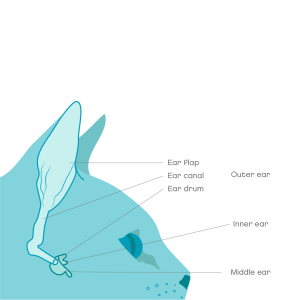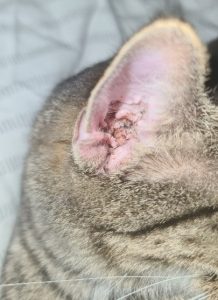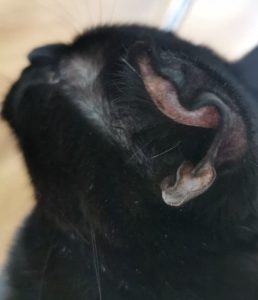Ear problems can affect cats but tend to be less common than in dogs. There are many different causes of ear problems, the most common are infections and allergies.
Ear problems can affect cats of all ages, but some breeds may be at greater risk. While many cases are quick and easy to clear up, some causes of ear problems can lead to severe pain and lifelong treatment may be needed. Ear problems are often referred to as otitis, which means inflammation of the ear.
Overview
What are ear problems in cats?
Ear problems are a common complaint that vets see and treat on a daily basis.
- There are many different causes, with bacterial infections and allergies being the most common.
- Ear problems can happen at any age
- Infections are usually caused by reduction of air flow and the build-up of moisture
- Ear problems may be easy to treat if caught early. Simple infections should clear within 1-2 weeks with appropriate treatment.
- If not treated early, the ear can become damaged and thickened, and treatment becomes difficult
- Some cats may need lifelong treatment if they have underlying problems like allergies.
- It’s important to investigate for underlying causes; otherwise, the ear problems will continue to return
- May affect different parts of the ear: the ear flap and canal (Otitis externa), middle ear (Otitis media) or inner ear (Otitis interna)
- Most cases of middle or inner ear disease are due to bacteria after a ruptured eardrum. Ruptured ear drums are caused by repeated ear infections or incorrect cleaning.

Common causes of ear problems in cats include:
- Allergies: Food allergies and environmental
- Bacterial and fungal ear infections
- Ear mites and Mange
- Foreign bodies (such as grass seeds)
- Injuries, such as cat bite Wounds
- Ear growths, such as tumours or polyps
- Solar dermatitis: also known as ear edge dermatitis, is inflammation of the tip of the ear due to sunlight exposure. More common in cats with white ears.
- Vestibular disease in cats
- Incorrect ear cleaning
- Endocrine disorders, such as diabetes
Severe head shaking can lead to an aural haematoma.
Ear disease can be very painful in cats, and if not treated quickly, it may lead to lifelong problems and deafness. If your cat shows any signs of ear problems, speak to a vet as soon as possible to discuss the next steps.
Our Joii vets are available 24 hours a day if you have any concerns.
Symptoms
Symptoms of ear problems in cats
One or both ears may be affected
- Ear irritation: scratching at the ears or rubbing them on the floor
- Head shaking
- Pain: avoidance or aggression when touched near the head or ears
- Red, inflamed skin inside the ears
- Discharge, such as wax, pus, or blood inside the ears
- Hair loss or skin sores around the ears
- A bad smell from the ears
- A head tilt
- Loss of balance
- A swollen ear tip is called an aural haematoma
- Reduced appetite, or lethargy


Risk
Are some cats more at risk of ear problems than others?
Any cat, regardless of age or breed, can develop ear problems. However, there are some known risk factors including
- Breeds: Scottish Fold, Himalayan, and Persian cats. These breeds are at higher risk due to the abnormal shape of the ear.
- Regular exposure to moisture, such as too frequent or incorrect cleaning
- Kittens and outdoor cats are more at risk of ear mites
- Tumours and masses are more common in older cats
- Immunocompromised cats, such as those with FIV or FeLV are at a higher risk of developing ear infections
Is my family at risk of catching ear problems from cats?
None of the common causes of ear disease are known to transfer from cats to humans.
Diagnosis
How are ear problems diagnosed in cats?
The diagnosis of ear problems will usually begin with a full physical exam, including an otoscopic exam. Your vet will look down the ear canal with a scope to check the eardrum and check for any abnormalities, such as foreign bodies or growths.
Depending on the findings, further tests may include
- A swab of the ear, for cytology, to find out if bacteria, yeast, mites or other cells are present
- A swab may be sent off to see what medication is best to treat the infection
- Ear flushing, to clean the ear thoroughly
- A biopsy of the skin or any growths in the ear
- Imaging: Skull x-rays, CT or MRI may be recommended for certain conditions, especially those affecting the middle and inner ear
- Other tests to check for underlying diseases include diet trials, allergy skin testing, and blood and urine tests.
The above tests often require sedation or anaesthesia. Ear problems can be extremely painful, and some cats may not even allow a visual exam without it.
Vet treatment
Vet treatment of ear problems in cats
Your vet may diagnose an ear infection based on how the ear looks and a simple swab of the ear discharge.
A visual exam is extremely important to check that the eardrum is intact, as most ear drops can cause severe side effects if used when the eardrum is not intact.
Treatment will usually involve one or more of the following:
Ear cleaners
- To clean and soothe the ear canal
- Help break up the wax and allow the medicated drops to be more effective
- Some have antibacterial and antifungal properties
Medicated ear drops
- Usually contain a combination of antibiotic, antifungal, and anti-inflammatory ingredients.
- Range of different types; some are applied twice daily, some are longer-lasting, up to a week
- Often used after a swab has been taken, once results are known for what type of bacteria or yeast is present
- The length of course may range from 7 days to 14 days or longer, depending on how severe the infection is or what type of infection is present
- Always complete the course as advised by your vet
Oral medications
- May be used if ear drops are not possible due to too much pain or a ruptured eardrum
- Often used if middle or inner ear disease is involved
- May be used before a course of ear drops to help reduce thickening inside the ear canal
- The most common are antibiotics and anti-inflammatory medications
Surgery
- Simple procedures such as ear flushing (to thoroughly clean the ears) or removal of foreign bodies
- Removal of the tip of the ear if severe solar dermatitis is present
- More complex surgery may be required for ear problems that are not clearing with medical treatment or badly damaged ears
- There are several different techniques: lateral wall resection, vertical ear canal ablation, and total ear canal ablation (TECA).
Other treatments may be necessary for any of the underlying diseases, such as ear mites. Find out more about the specific treatments for these conditions by following the links to the articles.
Home treatment
How to look after a cat with ear problems at home
Always speak to a vet before using any home remedies for your cat’s ears. Some products may make the symptoms worse.
- Make sure to use any medication as advised by your vet. Do not skip any doses and finish the course. If you are struggling to use the medication, speak to your vet; an alternative may be available. If the problem persists, make sure to take your cat back for a recheck as soon as possible.
- Speak to a vet as soon as signs of ear problems begin. Ear disease is easier to treat in the beginning, before the ear becomes thickened or develops resistant infections.
- Make sure your cat is up-to-date on parasite preventatives for fleas; these often cover ear mites too. These are important even if your cat does not go outdoors.
- Ear cleaners may be all that is needed for mild problems.
- A buster or inflatable collar helps to prevent self-trauma to the skin around the ears
- If underlying allergies are suspected, a special diet can be used long-term for management.
- Skin supplements containing omega oils can help reduce itching and improve the skin’s barrier function.
Our Joii vets are available 24 hours a day for advice about what ear cleaners, diets, or supplements might be useful for your cat.
Tips on how to live with a cat with ear problems
Ear problems can be frustrating to diagnose and treat.
- Some cases will respond well to a course of medication and never return. Unfortunately, some cases may return within a few months or not respond to the first course of medication.
- The prognosis of ear disease is generally good, but will often need long-term management.
- Higher costs may be involved if surgery or allergy medication is required.
- Make sure to speak to a vet as soon as the ear problem flares up. This is especially important if it does not resolve after a course of medication.
Prevention
Tips on how to prevent ear problems in cats
Some causes of ear problems are not preventable, but there are ways to reduce the severity of the symptoms or how often they occur.
- Reduce moisture: keep ears as dry as possible at all times.
- Get your cat used to their ears being handled and cleaned when they are young.
- Use a cat-safe sunblock if your outdoor cat has white or pale ears.
- Manage allergies with appropriate diet and medication.
- Keep your cat up to date with parasite preventative that covers against fleas and mites.
- Keep the hair around the entrance to the ear as low as possible to allow good ventilation.
- Clean the ears regularly with an appropriate cleaner. Use a cleaner that is pH-neutral. Different ear cleaners may be recommended depending on the type of ear disease.
- Avoid cleaning the ears too often. Once every 7–14 days is usually enough, unless there is an infection present. Speak to our Joii team to find out more.
- Check your cat’s ears regularly, especially if they go outdoors. Remove any foreign material, such as grass seeds, before they work their way into the ear canal.
When to worry
When you should be worried about ear problems in cats
Seek help from your local vet if:
- Your cat’s ears are extremely itchy or painful
- Your cat has a head tilt or loss of balance
- Your cat’s ear infection has not cleared with the medication
Call us and speak to one of our Joii Vets if:
- You have any questions about what ear cleaners are safe for cats
- You want advice on how to clean your cat’s ears
- Your cat has repeated problems with ear infections and you are not sure what to do next








